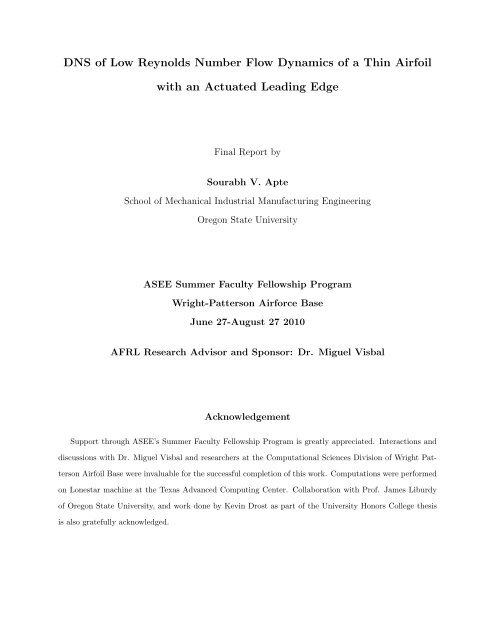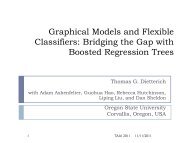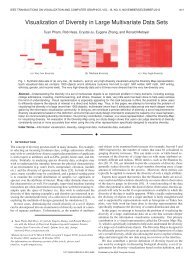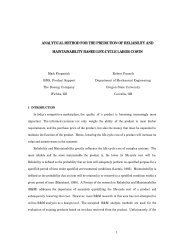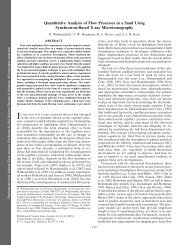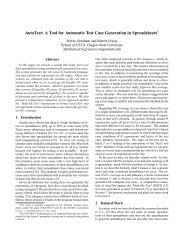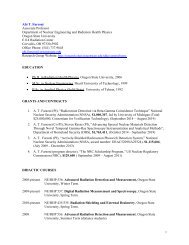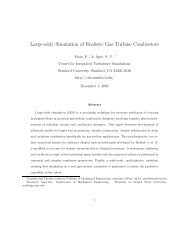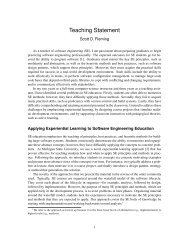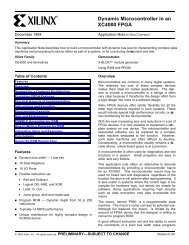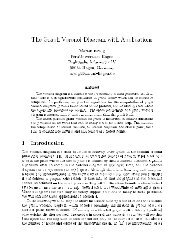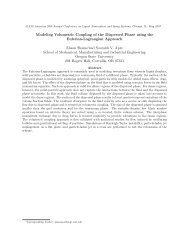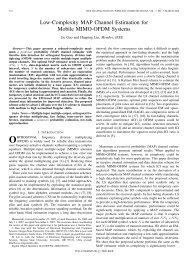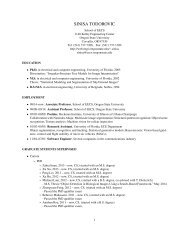DNS of Low Reynolds Number Flow Dynamics of a Thin Airfoil with ...
DNS of Low Reynolds Number Flow Dynamics of a Thin Airfoil with ...
DNS of Low Reynolds Number Flow Dynamics of a Thin Airfoil with ...
- No tags were found...
You also want an ePaper? Increase the reach of your titles
YUMPU automatically turns print PDFs into web optimized ePapers that Google loves.
1 Introduction and ObjectivesThe desire to advance the use <strong>of</strong> thin, low Re wings at small scales introduces flow dynamics that significantlyinfluence their performance and flow control. At sufficiently high angles <strong>of</strong> attack during transients, flowover an airfoil separates, which can lead to a ‘dynamic stall’ condition. One major concern <strong>of</strong> thin airfoildesign, when operating at high lift conditions, is the unsteady nature <strong>of</strong> separation at the leading edgeresulting in a Kelvin-Helmhotlz type flow instability [1, 2, 3]. This causes the generation and convection <strong>of</strong>low frequency large vortical structures that have a strong influence on unsteady lift. Very early works onflow over hydr<strong>of</strong>oils and wings [4, 5] have shown a strong correlation <strong>of</strong> pressure in the separation bubble<strong>with</strong> the onset <strong>of</strong> stall conditions.For very low <strong>Reynolds</strong> number [O(100)], the unsteady flow characteristics <strong>of</strong> thin wings undergoingplunge maneuvers show downstream advection <strong>of</strong> the leading edge vortex and the frequency for unsteadylift characteristics [6]. Other studies <strong>of</strong> unsteady flow characteristics during pitching include [7, 8, 9, 10]and recent computational work based on immersed boundary technique under the AFOSR MURI programat CalTech on impulsively started wing [11, 12, 13]. It is clear from these and other studies that vortexshedding, advection, and strength is highly dependent on the maneuvering characteristics.Extensive studies at low Re have been carried out to better understand the flow and its dynamic characteristicsfor stability and control considerations. At low Re, thin flat airfoils actually delay stall to higherangles <strong>of</strong> attack when operating at lower aspect ratios, although the lift is somewhat lower at lower angles <strong>of</strong>attack [14]. It has been shown that a cambered plate (4%) performs better in the Re range <strong>of</strong> 10 4 –10 5 [14],and has a low sensitivity to the trailing edge geometry and the turbulence intensities [15]. Although thinairfoils show many advantages at low Re, such as high lift-to-drag ratio, they exhibit wide fluctuations inlift mainly caused by the unsteady flow separation at the leading edge ([16] and references therein). Thecharacter <strong>of</strong> this separation is highly unsteady, at fairly low frequencies, and generally <strong>with</strong>out reattachmentif the angle <strong>of</strong> attack is sufficiently large [16], however, most <strong>of</strong> this work is at somewhat higher Re(∼ 3 × 10 5 ). As the angle <strong>of</strong> attack is increased to the stall condition there is a rise in the unsteady character<strong>of</strong> the lift coefficient, <strong>with</strong> rms fluctuations on the order <strong>of</strong> 0.1–0.2. This is in contrast to the unsteadylift coefficients which are on the order <strong>of</strong> 0.03 for trailing edge stall. The thin airfoil stall versus angle <strong>of</strong>attack is associated <strong>with</strong> a drop in lift coefficient, a rise in unsteadiness and then a subsequent rise in lift,and it is asserted that the unsteadiness in lift is a direct consequence <strong>of</strong> the leading edge separation [16].Effect <strong>of</strong> impressed acoustic excitation <strong>of</strong> the airfoil as a method <strong>of</strong> flow control [17] has been investigatedto reduce the unsteadiness in flow separation and lift oscillations. Vorticity mapping, to quantify unsteadyflow associated <strong>with</strong> airfoil motion, has been used to correlate thrust <strong>with</strong> shedding frequency [18].1
Leading Edge Actuation:The primary objective <strong>of</strong> the proposed work is toinvestigate, using direct numerical simulations the potentialbenefits to the lift and drag characteristics <strong>of</strong>an oscillating leading edge on thin, flat airfoils at low<strong>Reynolds</strong> numbers [O(10 4 )] <strong>with</strong> and <strong>with</strong>out pitchingFigure 1: Schematic <strong>of</strong> a thin, flat airfoil <strong>with</strong>a leading edge actuator. A typical flap, length(l f ) approximately 30% <strong>of</strong> the chord (c), will behinged to the airfoil body to facilitate change inflap angles (θ). The angle <strong>of</strong> attack (α) will alsobe changed representative <strong>of</strong> pitching maneuvers.maneuvers (see Figure 1). The central hypothesesdriving the proposed research are: (i) Oscillatory actuation<strong>of</strong> the leading edge provides an effective mechanismto control transients in lift, drag, and pitching momentduring steady and transient flow conditions at low<strong>Reynolds</strong> numbers [O(10 4 )] by reducing the strength <strong>of</strong>the generated vortex and weakening the separation bubble;(ii) Actuation time scales and waveforms associated <strong>with</strong> the flap motion can positively influence the liftcharacteristics by altering the leading-edge vortex shedding, separation-bubble dynamics, and dynamic stallconditions.The chief aim is to parameterize the flow field and vortex dynamics over a range <strong>of</strong> angles <strong>of</strong> attackand flap angle for a fixed flap-length to chord ratio at low <strong>Reynolds</strong> numbers under steady and unsteadyflow conditions representative <strong>of</strong> an airfoil undergoing characteristic maneuvers. New insights into the flowdynamics can then be used to develop a reduced-order models for active control <strong>of</strong> the lift-to-drag ratio. Thefollowing research tasks are identified to test the defined hypotheses:I. Verification <strong>of</strong> the Fictitious Domain Approach for Flapping Leading Edge: First, thefictitious domain method developed by Apte et al. [19] is used to compute flow over a plunging SD7003 airfoil,commonly used for study <strong>of</strong> MAVs. Results for low Re (1000 and 10000) is verified against AFRL’s highfideltiyFDL3DI solver [20, 21]. A grid-refinement study is also performed to identify resolution requirementsnecessary to capture important flow features.II. Quantify the effect <strong>of</strong> dynamic changes in angles <strong>of</strong> attack relative to flap angle on thelift and drag: Effect <strong>of</strong> sinusoidal variations in the angle <strong>of</strong> attack ( ˙α) actator angles ( ˙θ) at a fixed angle<strong>of</strong> attack (α = 20 ◦ ) on the lift and drag coefficients is investigated for a wide range <strong>of</strong> oscillation frequencies(1, 3, 5, 10, and 20 Hz) and actuation amplitudes (∆θ = 2.5 ◦ , 5 ◦ , 10 ◦ ). Effect <strong>of</strong> the actuation on the meanlift-to-drag ratio is computed and compared <strong>with</strong> the no-actuation case.2
2 Methodology:The computational algorithm for flow over immersed objects on simple Cartesian grids is based on a fictitiousdomain approach [22, 19, 23]. In this approach, the entire fluid-rigid body domain is assumed to be anincompressible, but variable density, fluid. The flow inside the fluid region is constrained to be divergencefreefor an incompressible fluid, whereas the flow inside the particle (or rigid body) domain is constrainedto undergo rigid body motion (i.e. involving translation and rotational motions only). For specified motion<strong>of</strong> the rigid body, the rigidity constraint force can be readily obtained once the location <strong>of</strong> the boundary <strong>of</strong>the rigid body is identified by making use <strong>of</strong> marker points in a banded region surrounding the rigid bodysurface (figure 2).The marker points provide subgrid scale resolution, improving theaccuracy <strong>of</strong> interpolations between the marker points and the backgroundgrid. Due to rigidity <strong>of</strong> the moving object, there is no relative motionbetween the marker points, and all points move <strong>with</strong> the same, specifiedvelocity field. The rigidity constaint force is then enforced explicitly ina standard fractional step scheme. The flow solver is fully parallel andbased on conservative finite volume scheme [25] for accurate prediction <strong>of</strong>turbulent flows and has been verified on a variety <strong>of</strong> canonical test casessuch as flow over a cylinder, sphere and a NACA airfoil to show goodpredictive capability.3 Results:Computational studies involving verification tests on a SD7003 plungingFigure 2: Use <strong>of</strong> banded markerpoints to identify the rigid bodysurface in a fictitious-domain approach[24, 19].airfoil and parametric studies <strong>of</strong> leading edge actuation for a thin, flat airfoil are presented below.3.1 Verification TestsThe fictitious-domain approach was used to simulate flow over a plungingSD7003 airfoil, corresponding to the high-fildeity simulations by Visbal[20, 21].This configuration has also been a subject <strong>of</strong> several experimentaland numerical studies [26]. The case <strong>with</strong> chord <strong>Reynolds</strong>numbers <strong>of</strong> 10 3 and 10 4 were used to assess the predictive capability <strong>of</strong>the present solver. This airfoil has a maximum thickness <strong>of</strong> 8.5% andFigure 3: Cartesian grid resolutionfor plunging SD7003 cases.a maximum camber <strong>of</strong> 1.45% at 35% chord length. The original sharp trailing edge was rounded <strong>with</strong> acircular arc <strong>of</strong> radius (r/c ≈ 0.0004, c is the chord length) corresponding to the simulations by Visbal [20].3
The grid resolution and time-step used forthis study are given in figure 3. A simple Cartesiangrid refined in a small patch around theairfoil was used.Two grid points were usedin the spanwise direction, <strong>with</strong> periodic conditions,for this two-dimensional study.Visbal[21] used a body-fitted, moving grid, sixthorderaccurate algorithm <strong>with</strong> wall-normal resolution<strong>of</strong> 0.00005 and 0.0001 for baseline andcoarse grids, respectively. The correspondingresolutions along the airfoil surface were 0.005and 0.01, respectively.Figure 4: Instantaneous, out-<strong>of</strong>-plane vorticity contours(ω z c/U ∞ , range ±40) for Re = 10, 000. Left panel: presentresults, right panel: results by Visbal [21] on baseline grids.Compared to this, thepresent baseline resolution isfiner along the airfoil surface,but coarser in the wall-normaldirection.Use <strong>of</strong> finer resolutionsare feasible, however, thesimulations on thin, flat airfoilas planned in this study usedsimilar resolutions as in figure3, in order to facilitate severalparametric studies in reasonabletime. The verificationstudy for SD7003 airfoil, thusallows estimation <strong>of</strong> the predictivecapability <strong>of</strong> the solveron grid resolutions comparableto that used for the thin,flat airfoil. The time-step usedfor the present incompressibleFigure 5: Two-dimensional loads on SD7003 airfoil at two different<strong>Reynolds</strong> numbers compared <strong>with</strong> the high-fidelity solver, FDL3DI [21]:(a,b) Drag and lift coefficients at Re = 1000, (c,d) drag and lift coefficientsat Re = 10000. Predictions for baseline, coarse and non-uniform grids areshown.flow simulations is also 4-timeslarger than those used by Visbal [21] in his compressible flow solver.4
Figure 7: Effect <strong>of</strong> static actuation <strong>of</strong> the leading edge on flow structure as well as lift and drag for α = 20 ◦ ,Re = 14700: (a-d) out-<strong>of</strong>-plane vorticity contours (ω z c/U ∞ = ±60) for θ = 0 ◦ , (e-h) out-<strong>of</strong>-plane vorticityfor θ = 20 ◦ (snapshots are tU ∞ /c = 2.06 apart) , (i) temporal evolution <strong>of</strong> drag coefficient for θ = 0, 20 ◦ , (j)temporal evolution <strong>of</strong> lift coefficient for θ = 0, 20 ◦ .The effect <strong>of</strong> static actuation <strong>of</strong> the leading edge,<strong>with</strong> θ = 20 ◦ for an angle <strong>of</strong> attack (α) <strong>of</strong> 20 ◦ , was firstinvestigated (see figure 7). For no actuation, the lift anddrag coefficients vary significantly for this high angle <strong>of</strong>attack, showing fluctuations due to passage <strong>of</strong> vorticalstructures pas the leading edge. The flow is highly separated<strong>with</strong> a large wake region.With simple staticactuation, the magnitude <strong>of</strong> the mean drag coefficient isreduced (from 0.502 <strong>with</strong>out actuation to 0.369 <strong>with</strong> actuation),whereas the mean lift coefficient is not alteredsignificantly (from 1.03 <strong>with</strong>out actuation to 0.97 <strong>with</strong>actuation). Also <strong>with</strong> actuation, the range over whichthe lift and drag coefficients oscillate are reduced significantly.The mean lift-to-drag ratio is increased from 2.06Figure 8: Effect <strong>of</strong> dynamic actuation <strong>of</strong> the leadingedge on flow structure as well as lift and dragfor α = 0 ◦ , Re = 14700: (a-d) out-<strong>of</strong>-plane vorticitycontours (ω z c/U ∞ = ±60) for ∆θ = ±10 ◦ at10 Hz, (e) temporal evolution <strong>of</strong> drag coefficient,(f) temporal evolution <strong>of</strong> lift coefficient.(<strong>with</strong>out actuation) to 2.63 (<strong>with</strong> actuation), a 27.67%increase. These results are obtained on the baseline grid, <strong>with</strong> similar levels <strong>of</strong> increase in mean lift-to-drag6
atio shown by the coarse grid.Figure 9: Out-<strong>of</strong>-plane vorticity contours (ω z c/U ∞ = ±60) showing effect <strong>of</strong> dynamic actuation <strong>of</strong> the leadingedge (∆θ = ±5 ◦ ) on flow structure for α = 20 ◦ , Re = 14700. Left panel: 10 Hz (k = 5.71), middle panel:5 Hz (k = 2.86), right panel: 1 Hz (k = 0.57) showing different phases <strong>of</strong> the actuation cycle.High frequency, periodic plunging applied to entire airfoil can result in a net thrust [21], for example thecase <strong>of</strong> SD7003 airfoil discussed earlier leads to a net mean thrust. In order to investigate if the presentleading edge actuation also provides a thrust component, simulations were performed at 0 ◦ angle <strong>of</strong> attack<strong>with</strong> the leading edge actuated to undergo sinusoidal oscillations around the mean position at differentfrequencies and amplitudes. Figure 8 shows the flow structure and evolution <strong>of</strong> the out-<strong>of</strong>-plane vorticity atdifferent phase angles for an actuation at 10 Hz and amplitude <strong>of</strong> 10 ◦ at Re = 14700. Also shown is thetemporal history <strong>of</strong> drag and lift coefficients over a few cycles. It is observed from the vorticity contoursthat the oscillatory actuation creates periodic vorticies which pass along the airfoil resulting in oscillatoryvariations in lift and drag coefficients. For the actuator length to chord ratio <strong>of</strong> 30%, it was found that thesinusoidal actuation resulted in a small net mean thrust and also a positive mean lift. This study showsthat the present actuation does not result in a mean thrust. A longer actuator may be necessary to obtainthrust; however, as shown later, this simple actuation can indeed provide increased mean lift-to-drag ratioat higher angles <strong>of</strong> attack.The effect <strong>of</strong> dynamic actuation <strong>of</strong> the leading edge on the flow structure and drag/lift characteristics wasinvestigated by oscillating the leading edge around a mean angle <strong>of</strong> θ = 20 ◦ . Various frequencies (20,10, 5, 3,and 1 Hz) and amplitudes (10 ◦ , 5 ◦ , and 2.5 ◦ ) were investigated. Figure 9 shows the flow structure over one7
Figure 10: Temporal variation <strong>of</strong> drag and lift coefficients for different actuation amplitudes and differentfrequencies: (a) C d at 10 Hz, (b) C d at 5 Hz, (c) C d at 1 Hz, (d) C l at 10 Hz, (e) C l at 5 Hz, (f) C l at 1 Hz.cycle <strong>of</strong> actuation for an amplitude <strong>of</strong> ∆θ = ±5 ◦ at three different frequencies. It is seen that for the highfrequency <strong>of</strong> 10 Hz (k = 5.71), strong vortical structures created near the leading edge travel downstream.Vortex pairing mechanisms are observed <strong>with</strong> the vortices remaining close to the airfoil surface resulting ina smaller wake region. For lower frequencies (5 and 1 Hz), the separated flow near the leading edge and theshear layer oscillate <strong>with</strong> the actuator motion. The flow remains separated over most <strong>of</strong> the cycle giving alarger wake, and the breakdown <strong>of</strong> vortices observed in the high-frequency case is absent.Figure 10 shows the temporal variations <strong>of</strong> lift and drag coefficients for different frequencies and actuationamplitudes over a range <strong>of</strong> cycles. It is observed that for frequencies <strong>of</strong> 10 and 5 Hz, the lift/drag coefficientsare periodic <strong>with</strong> a phase difference compared to the actuator motion.For large amplitude actuations(10 ◦ ), the variations in lift and drag around a mean are also large. For lower frequencies <strong>of</strong> 1 Hz and also3 Hz (not shown), the drag and lift coefficients oscillate, however, several periods appear superimposed.The fluctuations show similar characteristics as the static-actuation, especially for low frequency and lowamplitude oscillations.Tables 1–3 summarize the effect <strong>of</strong> static and dynamic actuation <strong>of</strong> the leading edge on the mean lift anddrag coefficients for different actuation frequencies and amplitudes. Also compared are the mean lift-to-dragratios to that obtained <strong>with</strong> no actuation. It is observed that any actuation (static or dynamic) results inan increase <strong>of</strong> mean lift-to-drag ratio compared to no actuation. With static actuation (i.e. θ = 20 ◦ forα = 20 ◦ ), an increase <strong>of</strong> 27.7% was observed. As shown in figure 7, the temporal variation <strong>of</strong> the lift anddrag coefficients have a range <strong>of</strong> frequencies superimposed.8
Table 1: ¯Cd and ¯C l for Re C = 14700, ∆θ = 10 ◦ .α 0 θ frequency (reduced) ¯Cd ¯Cl ¯Cl / ¯C d % increase20 ◦ 0 ◦ 0 0.502 1.034 2.06 -20 ◦ 20 ◦ 0 0.369 0.97 2.63 27.7%20 ◦ 20 ◦ 10 Hz (5.71) 0.281 1.11 3.96 91.75%20 ◦ 20 ◦ 5 Hz (2.86) 0.32 0.75 2.35 13.75%20 ◦ 20 ◦ 1 Hz (0.571) 0.34 0.85 2.5 21.3%Table 2: ¯Cd and ¯C l for Re = 14700, ∆θ = 5 ◦ .α 0 θ frequency (reduced) ¯Cd ¯Cl ¯Cl / ¯C d % increase20 ◦ 20 ◦ 20 Hz (11.42) 0.36 1.06 2.94 43%20 ◦ 20 ◦ 10 Hz (5.71) 0.224 1.12 5 142%20 ◦ 20 ◦ 5 Hz (2.86) 0.31 0.76 2.45 19%20 ◦ 20 ◦ 1 Hz (0.571) 0.34 0.89 2.61 22.78%Table 3: ¯Cd and ¯C l for Re = 14700, ∆θ = 2.5 ◦ .α 0 θ frequency (reduced) ¯Cd ¯Cl ¯Cl / ¯C d % increase20 ◦ 20 ◦ 20 Hz (11.42) 0.3066 1.025 3.34 62.2%20 ◦ 20 ◦ 10 Hz (5.71) 0.30 0.934 3.11 51.1%20 ◦ 20 ◦ 5 Hz (2.86) 0.35 0.795 2.27 10.26%With dynamic actuation at high frequencies (10 and 20 Hz) further increase in mean lift-to-drag ratioswere observed. Specifically, for actuation amplitudes <strong>of</strong> ∆θ = ±5 ◦ and ±2.5 ◦ at high frequencies, anincrease in mean lift-to-drag ratio <strong>of</strong> more than 50% was observed. In addition, for dynamic actuation, thetemporal behavior <strong>of</strong> the lift and drag coefficients are periodic and predictable corresponding to the actuationfrequency. With higher amplitudes <strong>of</strong> actuator motion, the range over which the lift and drag coefficientsvaried also increased. For lower frequencies (1, 3 and 5 Hz), the increase in mean lift-to-drag ratio is lowerand the temporal variation in drag and lift coefficients show multiple frequencies superimposed similar to thatobserved in static actuation. These results suggest that high frequency actuation <strong>of</strong> the leading edge (eitheras designed or flow-induced) provide strong potential for development <strong>of</strong> control strategies. Specifically, theseeffects need to be investigated for airfoils undergoing transient maneuvers such as pitching or heaving.4 Summary and Future WorkEffect <strong>of</strong> oscillatory actuation <strong>of</strong> the leading edge <strong>of</strong> a thin, flat, rigid airfoil on MAV performance wasinvestigated using two-dimensional simulations at low <strong>Reynolds</strong> number (14700) and 20 ◦ angle <strong>of</strong> attack.A second-order accurate, fictitious domain method was used for this moving boundary problem on a fixedbackground mesh. The numerical method was thoroughly verified for its accuracy and predictive capabilityon canonical problems <strong>of</strong> flow over a cylinder and sphere at different <strong>Reynolds</strong> numbers, flow over a NACAhydr<strong>of</strong>oil, flow generated by an inline oscillation <strong>of</strong> the cylinder and flow over a plunging SD7003 airfoil.Reasonable comparison was obtained for plunging studies <strong>of</strong> SD7003 airfoil compared to AFRLs high-fidelity9
solver FDL3D for <strong>Reynolds</strong> numbers <strong>of</strong> 10 3 and 10 4 .<strong>Flow</strong> over a thin, flat airfoil at high angle <strong>of</strong> attack was study <strong>with</strong> and <strong>with</strong>out actuation <strong>of</strong> the leadingedge. Leading edge actuation involving rotation around a hinge located at 30% chord length can be usedto reduce the effective angle <strong>of</strong> attack <strong>with</strong>out significantly reducing the lift. Reduction in effective angle <strong>of</strong>attack and the added camber, results in reduced drag. A 27% increase in mean lift-to-drag ratio was observedfor static actuation cases, wherein the leading edge flap was horizontal (θ = 20 ◦ ). Actuated leading edgeat different reduced frequencies (0.57-11.42) and amplitudes (2.5 ◦ -10 ◦ ) were also studied. It was observedthat high frequency actuation <strong>of</strong> 10, 20 Hz (k = 5.71, 11.42), further increases the mean lift-to-drag ratio(> 50%). It also provides predictable pattern <strong>of</strong> lift and drag variations. Further analysis to study effecton mean flow/pressure, accounting for three-dimensional, transition effects as well as experimental data areneeded to corroborate these findings.The present work indicated that the leading edge actuation using a hinged flap provides a means todirectly influence the leading edge stall condition and unsteady lift behavior while not adding complexitiesassociated <strong>with</strong> blowing or suction that may not be practical, for small wings <strong>with</strong> weight constraints. Controlstrategies based on the present leading edge actuation are <strong>of</strong> direct relevance to small-size MAVs undergoingmaneuvers and are pragmatic as designing simple piezo-based actuators is straightforward.The presentsimple modification to the wing configuration also facilitates development <strong>of</strong> actuators and controllers forairfoils <strong>with</strong> considerable size and weight restrictions. For instance, typical characteristic lengths for MAVare in the range <strong>of</strong> 8–15 cm, <strong>with</strong> operating speeds on the order <strong>of</strong> 50 km/h. Improving the flight performance<strong>of</strong> these vehicles can enhance surveillance, search and rescue, and sensor mobility, while yielding vehiclesthat are more disposable.Although this work investigated rigid airfoils, the results are <strong>of</strong> direct relevance to other forms <strong>of</strong> leadingedge flow control which are more amenable to small scale MAV implementation <strong>of</strong> current interest to AFOSR;for example, surface deformations via piezo-electric actuators or aero-elastically tailored structures.Inaddition, concepts <strong>of</strong> passive control, <strong>with</strong> spring mounted hinge are also feasible leading to flow-inducedactuation <strong>of</strong> the leading edge.The summer research at AFRL’s computational sciences division has resulted in several opportunitiesfor future collaborations <strong>with</strong> AFRL scientists and researchers. At Oregon State, new projects for seniorstudents are initiated to build and modify the existing physical setup and measure lift and drag coefficients. AUniversity Honors College thesis [27] has also been completed and couple <strong>of</strong> students, supported as TeachingAssistants, are working toward their Master’s degree on related topics. This research work will be presentedat American Physical Society’s Division <strong>of</strong> Fluid <strong>Dynamics</strong> Meeting in Los Angeles in November.10
References[1] Y. Hoarau, M. Braza, Y. Ventikos, D. Faghani, G. Tzabiras, Organized modes and the three dimensionaltransition to turbulence in the incompressible flow around a NACA0012 wing, J. Fluid Mech. 496 (2003)63–72.[2] H. Nishimura, Y. Taniike, Aerodynamic characteristics <strong>of</strong> fluctuating forces on a circular cylinder, J.Wind Eng., Ind. Aerodynamics 89 (2001) 713–723.[3] C. Sicot, S. Auburn, S. Loyer, P. Devinant, Unsteady characteristics <strong>of</strong> the static stall <strong>of</strong> an airfoilsujected to freestream turbulence level up to 16%, Exp. in Fluids 41 (2006) 641–648.[4] A. Fabula, This airfoil theory applied to hydr<strong>of</strong>oils <strong>with</strong> a single finite cavity and arbitrary free-streamlinedetatchment, J. Fluid Mech. 12 (1962) 227–240.[5] H. Kao, Some aspects <strong>of</strong> airfoil stall in low speed flow, J. Aircraft 11 (3) (1974) 177–180.[6] S. Brunton, C. Rowley, K. Taira, T. Colonius, J. Collins, D. Williams, Unsteady aerodynamic forces onsmall-scale wings: experiments, simulations and models, in: 46 th AIAA Aerospace Sciences Meetingand Exhibit, American Institute <strong>of</strong> Aeronautics and Astronautics, 1801 Alexander Bell Drive, Suite 500,Reston, VA, 20191-4344, USA,, 2008.[7] W. Geissler, H. Sobieczky, H. Vollmers, Numerical study <strong>of</strong> the unsteady flow on a pitching airfoil <strong>with</strong>oscillating flap, in: European Rotorcraft Forum, 24 th, Marseilles, France, 1998.[8] Y. Lu, G. Shen, G. Lai, Dual leading-edge vortices on flapping wings, Journal <strong>of</strong> Experimental Biology209 (24) (2006) 5005.[9] F. Muijres, L. Johansson, R. Barfield, M. Wolf, G. Spedding, A. Hedenstrom, Leading-edge vorteximproves lift in slow-flying bats, Science 319 (5867) (2008) 1250.[10] M. Dickinson, F. Lehmann, S. Sane, Wing rotation and the aerodynamic basis <strong>of</strong> insect flight, Science284 (5422) (1999) 1954.[11] K. Taira, W. Dickson, T. Colonius, M. Dickinson, C. Rowley, Unsteadiness in flow over a flat plateat angle-<strong>of</strong>-attack at low <strong>Reynolds</strong> numbers, in:45 th Aerospace Sciences Meeting and Exhibit,AIAA,(AIAA 2007-710).[12] K. Taira, T. Colonius, Three-dimensional flows around low-aspect-ratio flat-plate wings at low <strong>Reynolds</strong>numbers, Journal <strong>of</strong> Fluid Mechanics 623.
[13] T. Colonius, C. Rowley, G. Tadmor, D. Williams, K. Taira, W. Dickson, M. Gharib, M. Dickinson,Closed-loop control <strong>of</strong> leading-edge and tip vortices for small UAV, in: Conference on Active <strong>Flow</strong>Control, 2006.[14] T. Mueller, J. DeLaurier, An overview <strong>of</strong> micro air vehicle aerodynamics.’ Fixed and flapping wingaerodynamics for micro air vehicle applications, Progress in Astronautics and Aeronautics 195 (2001)1–10.[15] A. Pelletier, T. Mueller, <strong>Low</strong> <strong>Reynolds</strong> number aerodynamics <strong>of</strong> low-aspect ratio, thin/flat/camberedplatewings, J. <strong>of</strong> Aircraft 37 (5) (2000) 825–832.[16] A. Broeren, M. Bragg, Unsteady stalling characteristics <strong>of</strong> thin airfoils at low <strong>Reynolds</strong> numbers. Fixedand flapping wing aerodynamics for micro air vehicle applications, Progress in Astronautics and Aeronautics195 (2001) 191–213.[17] S. Yarusevych, P. Sullivan, J. Kawall, <strong>Airfoil</strong> boundary layer separation and control at low <strong>Reynolds</strong>numbers, Exp. Fluids 38 (2005) 545–547.[18] M. Fuchiwaka, K. Tanaka, M. Nakashima, Characteristics <strong>of</strong> dynamic thrust on an unsteady airfoilin pitching and heaving motions, FEDSM2007-37222, Proc. FEDSM20007, Joint ASME/JSME FluidsEngineering Conf., San Diego, CA.[19] S. Apte, M. Martin, N. Patankar, A numerical method for fully resolved simulation (FRS)<strong>of</strong> rigid particle-flow interactions in complex flows, Journal <strong>of</strong> Computational Physics (2008)doi:10.1016/j.jcp.2008.11.034.[20] M. Visbal, High-fidelity simulation <strong>of</strong> transitional flows past a plunging airfoil, AIAA paper 391 (2009)2009.[21] M. Visbal, R. Gordnier, M. Galbraith, High-fidelity simulations <strong>of</strong> moving and flexible airfoils at low<strong>Reynolds</strong> numbers, Experiments in Fluids 46 (5) (2009) 903–922.[22] S. Apte, N. Patankar, A numerical scheme for fully resolved direct numerical simulation <strong>of</strong> arbitraryshaped rigid particles in turbulent flows, J. Comp. Phy. (to be submitted).[23] S. Apte, J. Finn, A variable density fictitious domain method for fully resolved simulation <strong>of</strong> highdensityratio fluid-particle systems, in: ICMF2010, Seventh International Conference on Multiphase<strong>Flow</strong>, Tampa Bay, FL.
[24] S. Apte, N. Patankar, A formulation for fully resolved simulation (FRS) <strong>of</strong> particle–turbulence interactionsin two-phase flows, International Journal <strong>of</strong> Numerical Analysis and Modeling 5, Suppl (2008)1–16.[25] P. Moin, S. Apte, Large eddy simulation <strong>of</strong> multiphase reacting flows in complex combustors, AIAA J.(special issue on ‘Combustion Modeling and LES: Development and Validation Needs for Gas TurbineCombustors) 44 (2006) 698–710.[26] G. McGowan, A. Gopalarathnam, M. Ol, J. Edwards, D. Fredberg, Computation vs. experiment forhigh-frequency low-reynolds number airfoil pitch and plunge, AIAA 653 (2008) 2008.[27] K. Drost, Direct Numerical Simulation <strong>of</strong> a Flat Wing <strong>with</strong> a Movable Front Flap at High Angles <strong>of</strong>Attack and <strong>Low</strong> <strong>Reynolds</strong> <strong>Number</strong>s, University Honors College B.S. Thesis, Oregon State University.


